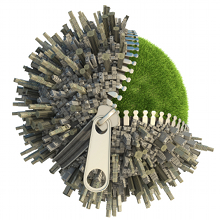Do you want to improve your working methods? – Change your environment
Datum: 2014-04-15 11:56

I have made the greatest changes and improvements in my structure in conjunction with changing offices or even jobs. When everything is new anyway, changing a habit does not feel like such a drastic change.
When I meet participants at my courses who recently started at a new job, I usually congratulate them. Few have a better opportunity to make changes in their routines as they do.
But, we lead an ordinary life between these types of larger changes. And we want to improve our structure then as well. Sometimes a change comes easy, and sometimes not. When you have repeatedly tried to become more structured but failed again and again, it is time for more radical measures to be taken.
It is ingrained in the walls
Cognition scientists say that we remember things easier in the environment where we first learned them. For instance, students tend to get higher results on exams when they are held in the same lecture hall where the students were taught. It turns out that small details in the environment and the physical space work as “memory-triggers” even if we are not conscious of this mechanism.
The researcher David Neal at the Department for Psychology and Neuroscience at Duke University says that when we do things we do very often, as habits and routines, we almost give the control of what we do to the environment we are in. This especially goes for tasks we tend to do in the same place. We do as we do when at work, since “it is how we do things at work”. When we get back from a meeting and have a bunch of papers in our hand, we place it to the left on the desk before we sit down since that is what we usually do when we return from a meeting.
It seems smart to create routines out of many things we do daily since they then happen almost automatically and we then have more energy for working concentrated on more demanding and important tasks.
The beauty of habits and routines is that we can design them in such a way that they benefit us optimally.
Neal has discovered that when we want to change the habits we repeat most, which are so highly influenced by our environment, it is the environment we should focus on changing (and hence enabling ourselves to establish the new habit easier).
The outer alternation inspires the inner change
Hence, if you determine that you want to work in a more structured manner than you previously have, for instance due to getting an idea for a change you want to make from reading Done!, make a change in the physical environment you usually perform the task in.
Do this
- Decide what work-related habit you currently have which you would like to somehow change.
- Make it clear to yourself how you would like to do what you do today differently. You could draw it out as a process, formulate it in terms of “When I …, I would like to from now on do … instead”, or you could write it on a note as a reminder to yourself.
- Think of a way to change the physical environment and making it different from how it usually is. For example:
- Get another type of pen to write with
- Change the placement of the speakers on the desk
- Create an empty space around your screen
- Rearrange your bookshelves
- Turn your desk so that it faces the other direction
- Ask your colleagues at the weekly meeting who would want to switch office with you. “I need to refine my way of working and I will be able to do this easier if I change my working environment.” The colleague who is willing to switch with you might also benefit from moving and hence it is a win-win situation.
- If you have a flex-office, choose to work in a different work-space from what you ordinarily work in.
- Change the computer desktop wallpaper and empty it of icons you do not use
- Remove the visitors-table and –chairs which you do not use anyway other than to put piles of paper on them
- Choose to drive a different route to work from now on
- Put your phone in the trunk when you are driving so that it is not easily available and hence tempting you to text, check Facebook or your e‑mail
- If your entire office is about to move to a different location soon, take this opportunity to make changes in your habits
- From now on, do the task/procedure/process in the new way you have invented.
- If you fall back into your old habits, think of more things in your physical environment which you can change and start over.
Easier to establish and easier to maintain
If you make alterations in the physical environment in conjunction with changing a working method, it will be easier to establish the new habits and then easier to maintain them as well. The improvement in your structure will not be as strenuous as it otherwise might be and it will be more difficult to fall back into old tracks again.
What is your method?
What changes could you make in your physical surroundings which would make it easier for you to establish new habits? Do tell us. Write a comment!




